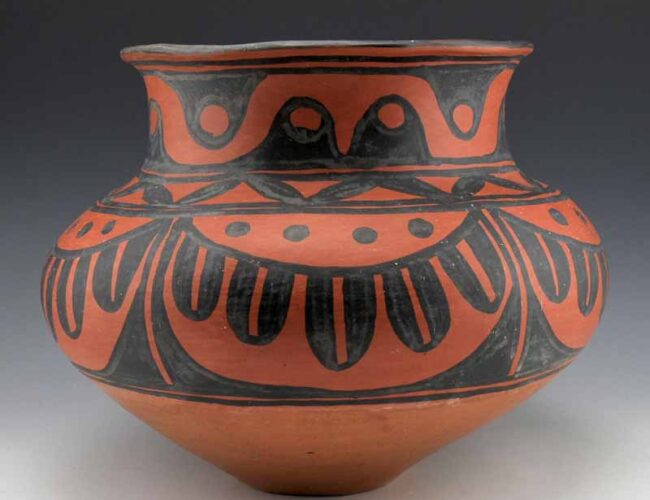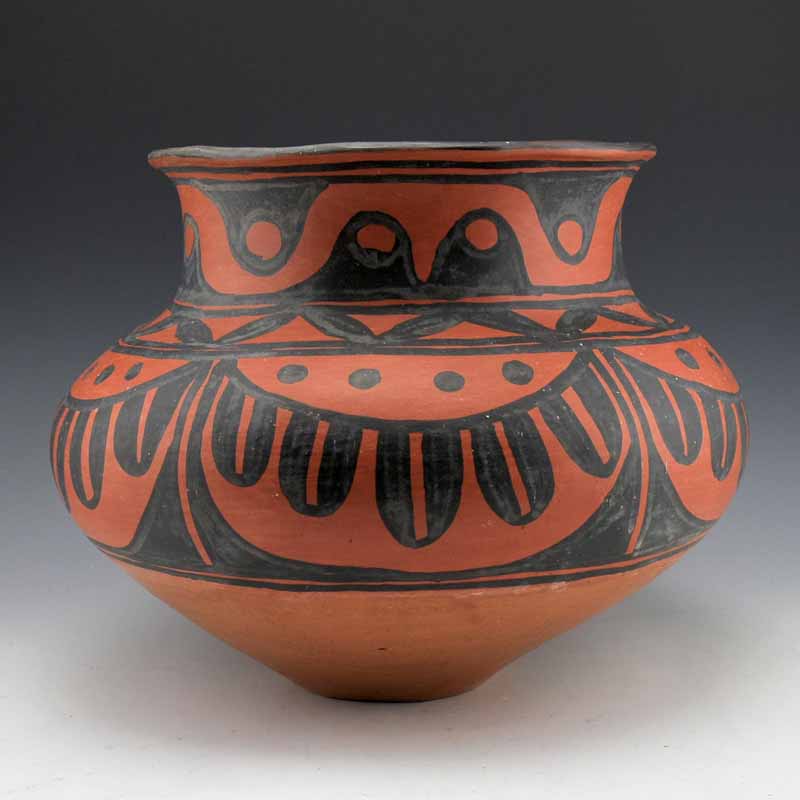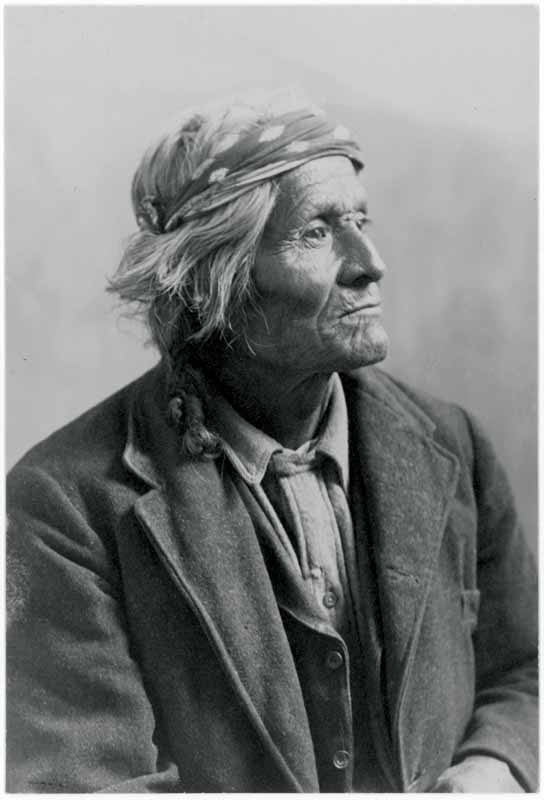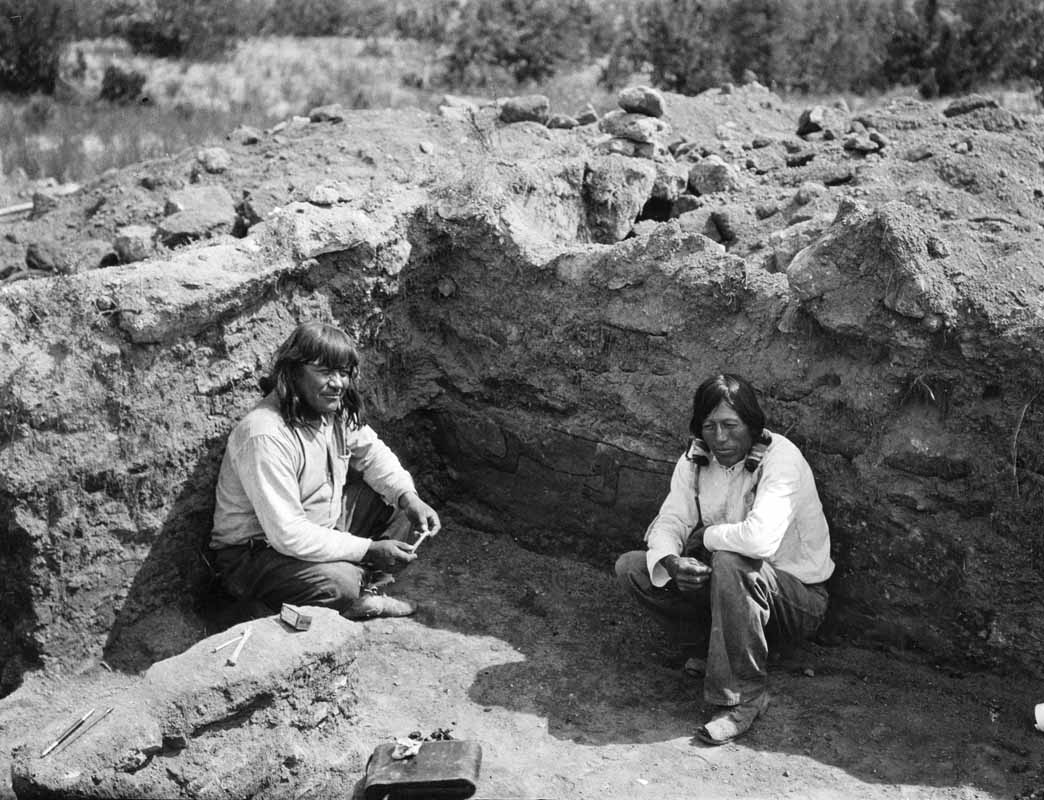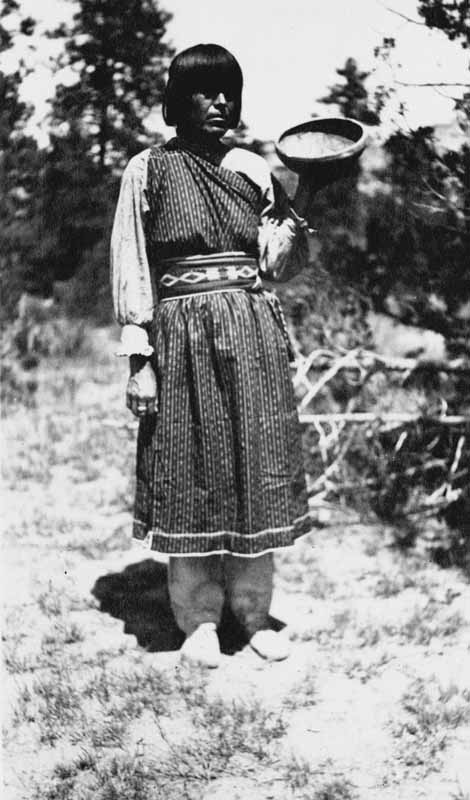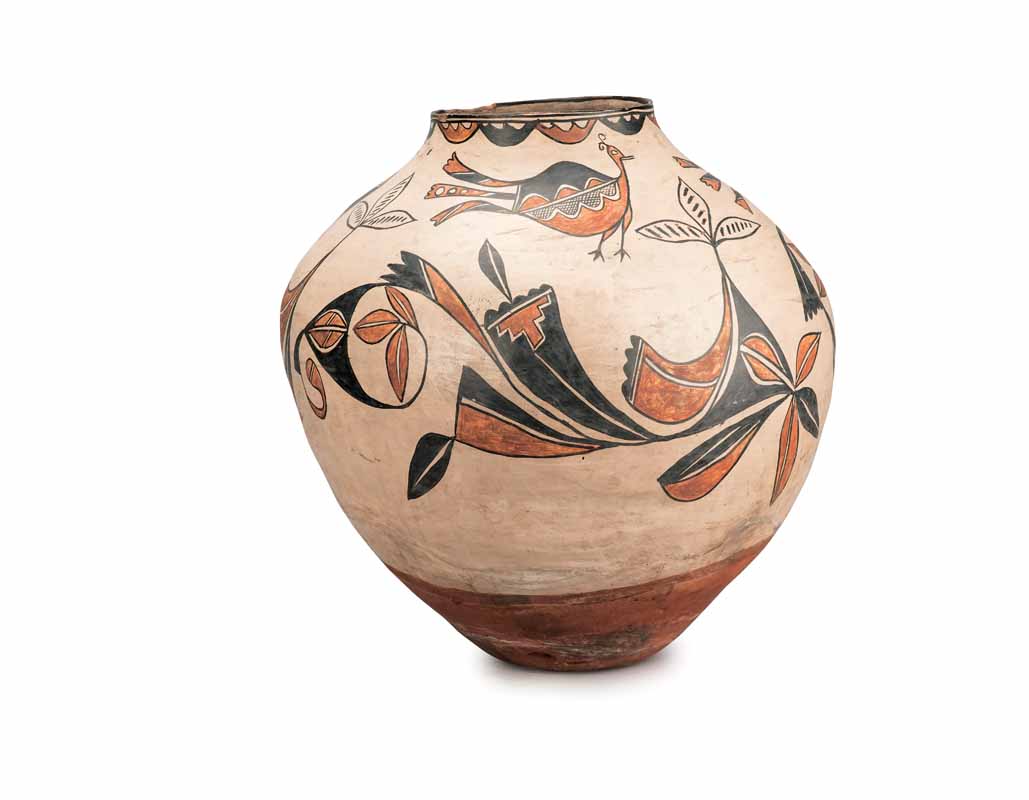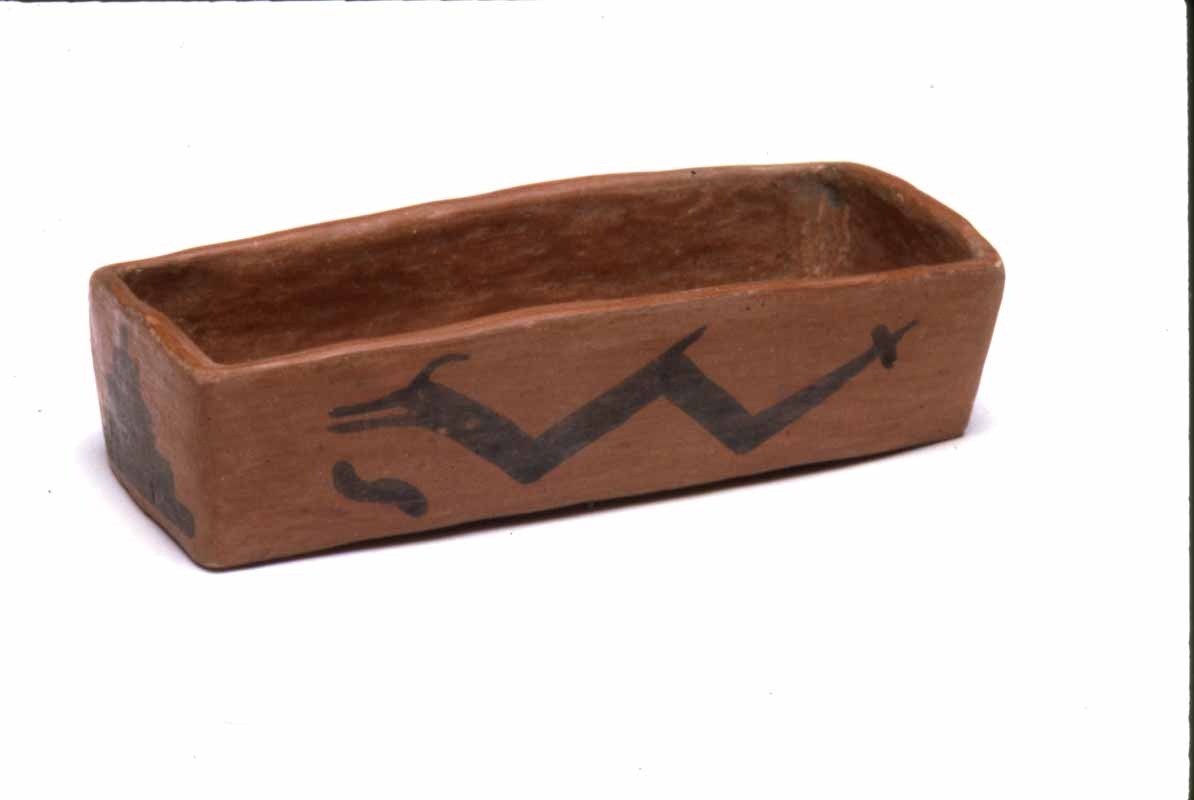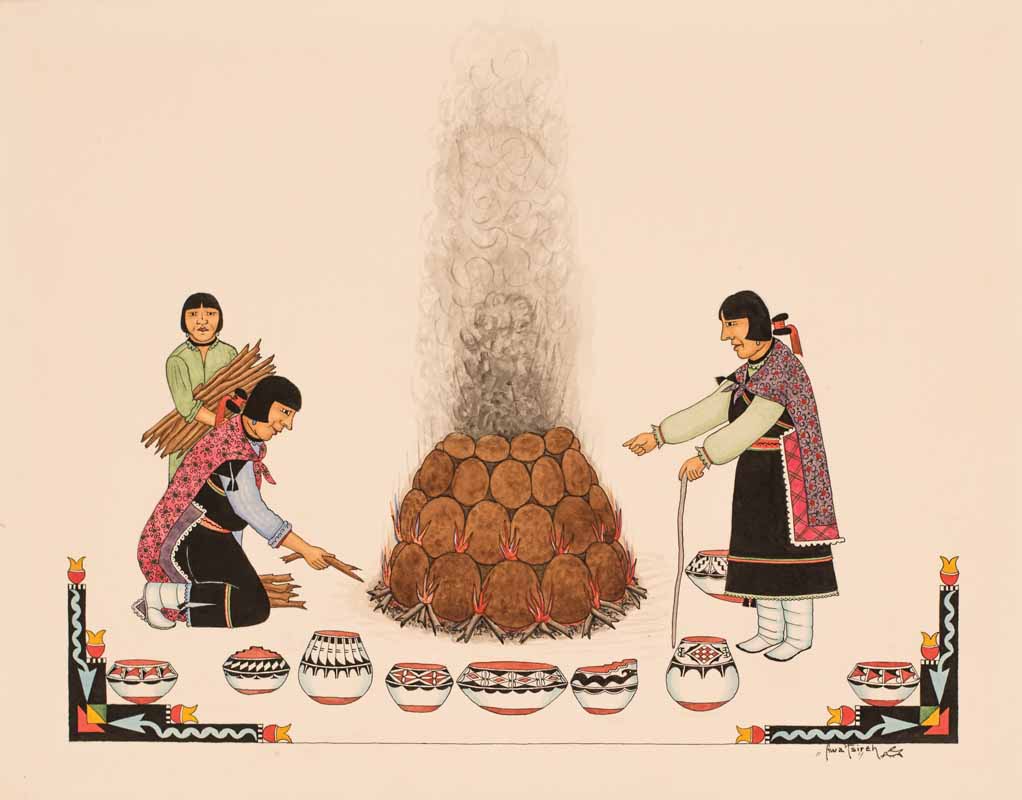Vessels of a Truth Obscured
A groundbreaking exhibition presents Pueblo art— and Santa Fe cultural history—from the perspectives of its makers.
BY BRUCE BERNSTEIN, ERIK FENDER, AND RUSSELL SANCHEZ
This past summer, at the Museum of Indian Arts and Culture, a years-long collaborative project culminated with the opening of San Ildefonso Pottery 1600–1930: Voices of the Clay. The exhibition is curated by two San Idlefonso potters and a Native arts scholar and is the first-ever exhibition on San Ildefonso pottery at a museum.
Our exhibition focuses on community and pottery, the voices of the clay. By presenting new research on San Ildefonso pottery of the last four centuries, the exhibition represents changing perceptions and understandings, striving to better appreciate and admire San Ildefonso potters and painters from their own perspectives. Ours is a story of contemporary pottery-making, one that is alive with newness, fertility, and the daily act of creation; not one of stepping back in time.
The MIAC collection includes hundreds of polychrome vessels made between 1600 and 1930, most of them unknown and not previously seen. The exhibition is the first that concentrates on the community and San Ildefonso pottery, rather than stories about individual achievement.
In addition, these pots are not signed. Prior to 1923 and the advent of Indian Market, potters didn’t sign pottery, a practice that privileges the individual over community. The absence of names on these pots, however, does not mean that their makers are unknown. Families did work together and have signature styles. While we still cannot definitively name potters in most instances, close examination allows us to create categories, and dividing the collection into pottery-making families.
Previous study of San Ildefonso has focused on the work of founding Museum of New Mexico Director Edgar Lee Hewett and a small group of potters. In this exhibition, we emphasize the community’s sentience and action over that of individuals. As we wrote in the exhibit introduction, “Along the way, we have learned even more about the creators of these beautiful works of art. Some names you will recognize, some will be new to you. Some still have stories to be told.”
These artworks tell the story of a singular alliance between the village of San Ildefonso and the fledgling museum. Two years before the museum was created, Hewett, in the company of San Ildefonso men, explored their homelands, spending countless hours immersed in its cultural and natural landscapes. From its start the museum relied on the men and women of the village for research, exhibition, publication, and education.
Some have suggested the San Ildefonso revival took place between 1910 and 1920 and at the instigation of the Museum of New Mexico, when archaeologists asked potters to use precontact designs found during excavations on the Pajarito Plateau. Our work displaces these stories through emphasizing community members’ participation and their responses to working with the museum employees. In addition, we advance an Indigenous understanding of the work by reconnecting it to the pottery revival that began in the 1870s by Yellow Deer and Mariantita Roybal.
Throughout our work, we’ve asked: How does a modern Native person make sense of centuries-old pottery designs, not just those unearthed through Hewett’s excavations but also those on the shelves of the MIAC?
San Ildefonso, a small but mighty village of extraordinarily visionary artists, is located just north of Santa Fe, along the Rio Grande at the base of the Pajarito Plateau. More populous pueblos might have provided assistance to Hewett in 1907, but Hewett turned to San Ildefonso and his acquaintance Weyima (Antonio Domingo Pena).
Hewett wrote in American Anthropologist: “I have had much valuable help from my much esteemed old guide, Wajima, a head man of the Powhoge (San Ildefonso) Indians. His scrupulous care to point out every ruin and to make known to me its traditions, his patience in explaining Tewa expressions and legends, and his help in interpreting the paleography of pottery have greatly advanced my knowledge.” (Tewa is a group of Native villages north of Santa Fe, six in all: San Ildefonso, Tesuque, Nambe, Pojoaque, Santa Clara, and Okay Owingeh.)
Perhaps more than any other individual, Weyima would create the ethos of the Museum of New Mexico: what the museum could be and how it could distinguish itself. Weyima’s perspective and worldview was rooted in the land and the ancient traditions that had sustained his people for millennia. He inspired Hewett’s novice curators to incorporate Native community-based insights into their exhibitions, programs, and research.
The village prospered in unexpected ways, too. After enduring years of degenerative governmental pressure to cease its traditional practices, their partnership with Hewett introduced their pottery to Anglo collectors. San Ildefonso artists also began making works on paper, a wholly new art form for Indigenous people in the region.
By the late nineteenth century, San Ildefonso, like all tribal economic systems across the Americas, was decimated, and tribal members were desperate to find ways to support their families and communities. US federal policies stymied economic development in tribal communities, and it was left to the community to find creative new ways to make a living by participating in the cash economy. As mentioned above, perhaps this was a reason to align themselves with Hewett, to learn more about the Americans who seemed to in the very least have some interest in their culture and history, as well as to assert their agency and authority about their culture and history. While Hewett, curators, and the cultural elite of Santa Fe portrayed Indians as a remembrance of the past, San Ildefonso people practiced a sentience in carving out new economic pathways.
In 1907—the first official year of the School for American Archaeology archeological field school (now the School for Advanced Research)—Hewett hired about twenty primarily Tewa men to excavate San Ildefonso graves and shrines. But Weyima had something different in mind through inclusion of three nephews: Crescencio Martinez, Alfredo Montoya, and Julian Martinez, all initiated and active Pueblo members. Weyima was aware of Hewett’s intentions. Perhaps he felt powerless to stop him, or he believed that sending inititated San Ildefonso men might hold Hewett in check, or that Weyima believed sending the young men would assert Tewa ownership of the Pajarito Plateau in as forceful way as possible.
Even when outside the village, the Tewa men would be expected by their people to behave within proper Tewa values and principles. Digging into old houses and graves must have felt like a compromise of those values. Although the thoughts of the Tewa men are not known, we do know they prepared by painting their faces red, as they would do for a ceremony and other prayers.
POTTERY
As time went on, the men would become talented and sought-after artists. Hewett asked the Tewa men to replicate the pottery designs being removed from the long-emptied rooms at ancestral sites. The Avanyu (water serpent) figure, once reserved for religious purposes and exclusively for use by men, would in the coming decade became a key element in made-for-sale pottery design iconography. Perhaps the use of such designs was an intentional act of healing. By creating new pottery that explicitly incorporated the sacred, a potter could remind himself, his family, and his community of their identity while broadening the communal ideologies of Pueblo society to include non-Indians. Creating watercolor paintings of dances for the non-San Ildefonso world could also have resulted from a decision to share, teach, and satisfy archaeologists’ insistent curiosity.
The dominant narrative is that Hewett unlocked the meanings of ancient dwellings and people in the course of his excavations. But what about the reactions and thoughts of the San Ildefonso community? In the virtual absence of recorded Tewa responses by Hewett and others, San Ildefonso people shared two responses of their work with non-Pueblo people: Pueblo watercolor paintings, and a pottery revival that had begun in the 1870s. Both are Indigenous responses from profound places within Tewa society. These responses form some of the museum’s first collections; indeed, it might be suggested that they form the core of the museum’s collections. Unlike other collection types, they are not restricted to one museum because of subject matter or the ethnicity of the maker, but are broadly and prominently displayed and interpreted throughout the museum in the Museum of Indian Arts and Culture, the New Mexico Museum of Art, and the New Mexico History Museum.
In 1908, the second summer of Pajarito Plateau excavations, the San Ildefonso men were invited to bring their families. While working at Tuyonuni, Hewett handed Maria Martinez, the wife of excavator Julian Martinez, a sherd of black-on-black Kapo pottery and asked her to replicate it for him.
Why did he do that? Plain, undecorated Kapo black ceramics had been a staple of Tewa homes for 300 years. This incident casts Hewett as a catalyst of the black-on-black pottery revival, undermining the role of the potting couple. Hewett later claimed his request was about sparking a pottery revival when, in fact, it was about proving his theories about San Ildefonso migration. Hewett’s primary interest was to return San Ildefonso people to pre-Spanish, pre-1600 conditions in order for them to align with his ideas of authenticity and purity. He believed the modern Pueblos were the remnants of far larger ancient civilizations.
Maria Martinez later recounted that Julian’s fascination with the black sherd Hewett handed over led to his experimentation with different dungs and methods in firing. Julian discovered that by lowering the firing temperature, the Kapo black ceramics would retain a highly polished finish, while at a higher firing temperature, they would turn gray. Julian also sought a paint that would work to embellish the black pottery. In the winter of 1919 and 1920, he concocted a mixture of clay and beeweed and used it to paint an an Avanyu on the jar. The spring 1920 El Palacio took note of this new style: “the largest black olla [water jar] is in dull finish with a plumed serpent in luster winding its sinuous form around the entire vessel, the effect being surprisingly impressive.”
This form of pottery combined elements of utilitarian wares with a wholly new vocabulary based upon ancestral design language. The lustrous black pottery emphasized form and materials, necessitating placement of the design field on the necks and shoulders of vessels in order to accentuate and elongate the pieces. In comparison, older polychrome styles featured designs on the entire body. Julian had experimented enough to know that the older or contemporary design repertoires of Tewa polychrome pottery would not work on the shiny black surface. By using prehistoric pottery designs, Maria and Julian would, within a few years, reinvent the Tewa pottery design repertoire for use on black-on-black pottery.
While the black sherd was the first pottery Hewett asked Julian and Maria to replicate, it was during the next summer, in 1909, that Hewett handed Maria Martinez a ball of clay he had found at the Santa Clara ancestral village of Puye and asked her to paint an Avanyu on it that was copied from a seven-foot-long rock art panel at Tsirege, a San Ildefonso ancestral village. Although Maria is listed as the maker, the Avanyu as painted on the square container was no doubt painted by Maria’s husband Julian, because at the time, the water serpent was strictly within the men’s realm of knowledge. Moreover, Maria’s choice to create a square bowl, generally associated with holding corn meal, indicates the sacredness of the subject matter. Over the next few years, Julian and Maria’s production focused on making bowls onto which Julian sometimes added designs faithfully copied from bowls excavated at Pajarito.
Along with working with Hewett as an excavator and a potter, Julian also served as a live-in janitor at the Palace of the Governors. During his second winter there, in 1910, Maria and their children joined him in Santa Fe. Maria enjoyed the conveniences of cooking on a wood-fueled cast-iron stove for the first time, and ten years later, she acquired one in her own home, as well as a sewing machine. Julian appreciated the electricity. As Maria told anthropologist Alice Marriott, while living at the Palace of the Governors, “I made pottery, because we could sell it. Long time before that we didn’t sell it, we just made it to trade with the Indians in the villages. Julian decorated a little, not much [previously], because they have those electric lights in the museum so he can work in the night times.”
In contrast, another husband-and-wife pottery team, Crescencio and Anna Martinez (Maria’s sister), took a different route in producing a new style of pottery. Unlike Julian, Crescencio was highly integrated with the village hierarchy, which required more conservative response to new pottery designs. He viewed, for example, using new iconography as pottery designs to be more appropriate than replication of something their ancestors had once created.
Anna and Crescencio’s approach used pots’ shoulder bands to divide the upper and lower areas, creating a representation of San Ildefonso’s philosophy of the upper and lower worlds. Crescencio also chose to incorporate the shoulder band into his designs. Also unique on these pots—Anna and Crescencio’s signature—is the use of flowers, or than povi, as seen painted on women’s cheeks for certain public dances.
Although Hewett took credit for the pottery revival in which the two sisters and their husbands participated, it originated before they were born in 1847 and who, other than her pottery and name, we know frustratingly little about. Yellow Deer’s innovations would be expanded by two of the most talented potters of their era, Martina Vigil Montoya and Dominguita Martinez Pino. Pino was Crescencio’s mother, and Montoya was married to Maria and Anna’s great-uncle. Yellow Deer created large, elegant shapes evoking San Ildefonso potting traditions and legacies, while also developing a new black-on-red style that revitalized the Pueblo’s polychrome tradition. San Idlefonso pottery had not witnessed such wholesale change since the mid-1700s, when pottery was transformed to integrate wheat into the community.
WATERCOLOR PAINTING
The impetus for the creation of Pueblo watercolor painting was the result of a relationship with Hewett and his employees. While pottery was acceptably made by San Ildefonso people and sold to the non-Pueblo world, there was no equivalent for watercolor paintings.
Alfredo Montoya was the first painter, and Crescencio Martinez soon followed, producing paintings for sale. Within a decade, Tonita Pena, Abel Sanchez, Alfonso Roybal, and Romando Vigil joined them. Each would follow in the conservative footsteps of Crescencio Martinez and Alfredo Montoya.
Watercolor paintings are a singular Indigenous art form, created from the values and worldviews of Pueblo people as only Pueblo men in higher-level positions of ceremonial activity could. In the first decade of painting, most of the images are self-portraits. They are accurate and authentic, a generous sharing with the non-Pueblo world as much as a reminder to outsiders of what constituted and what continued as Pueblo people’s own consciousness and the value of that consciousness in their survivance.
Both Crescencio and Montoya visualized their world, and in their first paintings established a new painting style of people within a space without definition of time and geography. Moreover, they depicted a public religious world, painting themselves simultaneously as participants and observers. Because the dances are part of the community, the two men probably discussed what to paint, deciding on animal dancers, principally buffalo and the deer, rams, and antelope that appear in the village for their annual January 23 Feast Day. These dances belong to the community and not to any particular group or society. Further, as public dances, what they painted could be seen by anyone watching.
They also chose to use the entire paper as the sacred space of the Pueblo plaza (bupingeh), on which the creation is ongoing; and therefore the paper, like the swept-dirt plaza, is not a void or empty. The plaza is the most dynamic place in the Tewa cosmos, and serves as the center of the world. It is the space where creation continues, where life is affirmed. The plaza is therefore a microcosm of the Tewa cosmos. The plaza is remarkable not for what it is, but what it is not. As Santa Clara scholar Rina Swentzell described, it is “empty so that it may be full over everything—the sacred and the everyday.” It is the space where dances are held, and the world is renewed through song and movement.
We believe this use of the paper as the sacred space of the plaza makes clear that careful and thorough discussion about how to paint their worldview on paper took place before a brush was put to paper.
Hewett considered the paintings to primarily be ethnography, and he used the works to illustrate his lectures and publications. He saw them as a way to salvage San Ildefonso culture for future generations, because Hewett, like most non-Pueblo people of his day, believed that Native identities would, within a generation or two, be subsumed by assimilation and acculturation.
THE NEW MUSEUM
Beginning in 1909 with the opening of the Palace of the Governors as home for the new Museum of New Mexico, the exhibitions consisted of archaeological work and collections from the Pajarito Plateau. In 1917, after the Museum was expanded to include the new Art Museum, Pueblo paintings were frequently exhibited there over the next fifty years, including permanent tributes to San Ildefonso in the courtyard.
Hewett’s work with San Ildefonso also led to the museum’s role in developing and staging Santa Fe’s first Fiestas and Indian Market. In retrospect, it appears that it was not always easy for Hewett to separate his aspirations toward building new institutions and using the insights shared with him by San Ildefonso people. For example, when he created the Santa Fe Fiestas, Hewett reinforced his own view of history and reconstruction of Pueblo cultures, knowledge he claimed he found in his Pajarito Plateau archaeological investigations. Instead of serving as active contributors, San Ildefonso people were merely his reenactment actors.
Hewett wrote, “the Pueblos are nine-tenths archaeology now,” and exhorted attendees to “catch our archaeology alive” at Fiestas through dance and historic pageantry. He directed San Ildefonso and other Pueblo people in great dance pageantry at the Santa Fe Fiestas, most famously in the House of the Sun, part of Fiestas that Hewett labeled in The Fiesta Book as “The Unknown Centuries, all part of the most important symbolic ceremonials of the Pueblo Indians.”
It is also noted that the “particular design used for this publication is taken from the buffalo hide shield of Weyima, ancient Sun Priest of San Idlefonso, given to the writer just prior to the passing of this remarkable old man.” Remarking on Weyima being “old” and the shield being given to him just before his death helped Hewett create the illusion of himself as inheritor and guardian of Weyima’s knowledge. Hewett strayed far from the truth in his comments, using Weyima’s death to give himself, his archaeology, and his events credibility. He exoticized Weyima and used his shield’s iconography after his death for marketing purposes.
In another instance of self-aggrandizement, in the winter of 1917, Hewett paid Crescencio to paint every San Ildefonso dance figure. Tragically, Crescencio passed in the worldwide flu epidemic in 1918. In Crescencio’s El Palacio obituary, Hewett assured readers that Crescencio, “just before his death,” had finished the paintings, forming a record of San Ildefonso ceremony. There are about twenty paitings from this commission, all from public dances already depicted in Crescencio’s other paintings, and none depict the dozens of private ceremonial figures that are not to be shared with outsiders.
Hewett used San Ildefonso people to promote his own goals and personal aspirations. He romanticized them, revealing an ambiguous and indeterminate role in reviving their patrimony, their culture, and their economy. In a 1922 El Palacio article, obstensibly about defending Pueblo water and land rights, Hewett advocated for allowing the Bursom Bill to pass, which would result in the dissolution of all remaining Pueblo land and water rights. While it seems Hewett’s support of the vast destruction of Pueblo communities was at odds with his rhetoric about the pueblos, it was actually not, because Hewett viewed authentic Pueblo culture as obsolete. He saw himself as a carrier of the torch, an inheritor of Pueblo culture from men like Weyima. He’d worked with Pueblo people on Pajarito Mesa and claimed extensive archaeological discoveries, thus making the continuation of the Pueblo villages unnecessary. In Hewett’s view, because Pueblo culture was represented in the Museum and its programs and exhibitions, it did not need to persist outside the museum’s walls.
Hewett also claimed credit for the genesis of San Ildefonso’s new pottery and paintings. He ignored the agency and conscious intentions of the makers and people of San Ildefonso, who used their own cultural mechanisms to preserve their culture and did not need the assistance of the museum and Hewett. As a way of detaching themselves from museum archaeologists’ persistent, insatiable questions, the San Ildefonso artists made watercolors and drawings. In the same way, when Hewett and others asked potters to make stultifying replicas of old pottery, they responded by creating new artistic forms while also adhering to their own long-standing pottery traditions and existing pottery revival. Our new exhibition collapses Hewett’s grandiose narrative, and for the first time presents pottery and paintings from the village’s viewpoint.
Elucidating these works’ meanings has required new collaborative strategies. Working with today’s potters and descendants is deeply gratifying, as they are intellectually engaged and do not hesitate to challenge flaccid ideas and concepts. But collaboration requires care, too. Outsiders need to guard against asking too many questions and taking concepts beyond the comfort range of individuals or the community.
Nonetheless, in this venture there is room for ideas that have never been explored in pottery scholarship; prior to this, people have engaged potters and community members on non-Pueblo terms, force-fitting Puebloan concepts into irrelevant frameworks.
Surviving self-sufficiently is an imperative in the San Ildefonso narrative, embedded in every pot and painting. It is the narrative of their continuous path of life, one of movement and adaptation while keeping core values and worldviews intact. It is the underlying message of the exhibition: the survival of a people on their own terms.
Russell Sanchez resides in San Ildefonso, where he is an active community member and potter. He is the recipient of a 2017 Governor’s Award for Excellence in the Arts. Erik Fender lives in San Ildefonso and is an active potter and jeweler. He teaches at the Poeh Center, and is working with Museum of New Mexico conservation department in development of collaborative conservation strategies. Bruce Bernstein is past chief curator and director of the Museum of Indian Arts and assistant director for research and collections at the National Museum of the American Indian, Smithsonian Institution. He serves presently as the historic preservation officer for the Pueblo of Pojoaque and is executive director of the Ralph Coe Center for the Arts.

